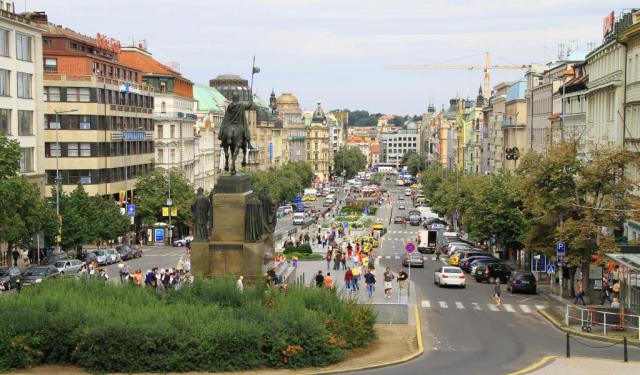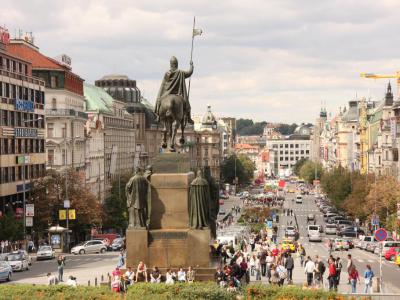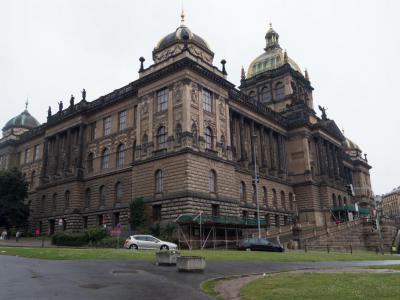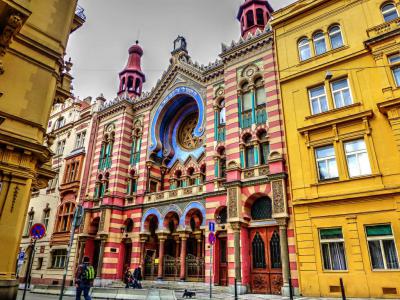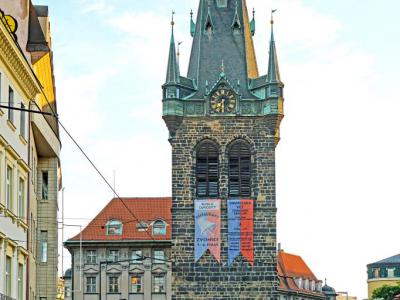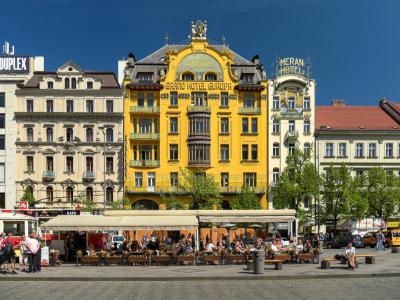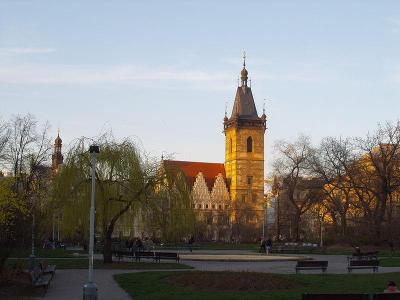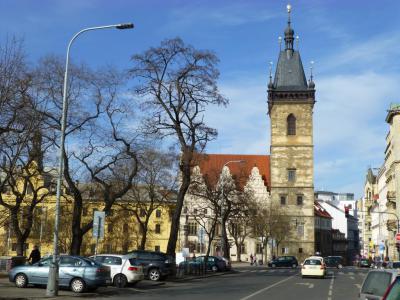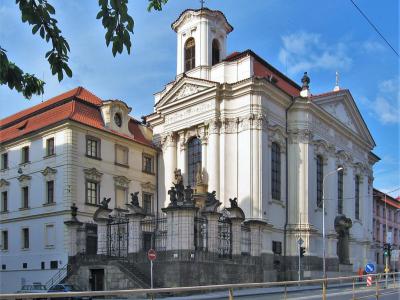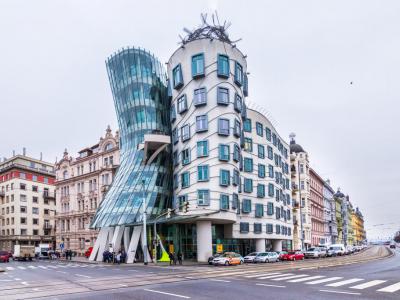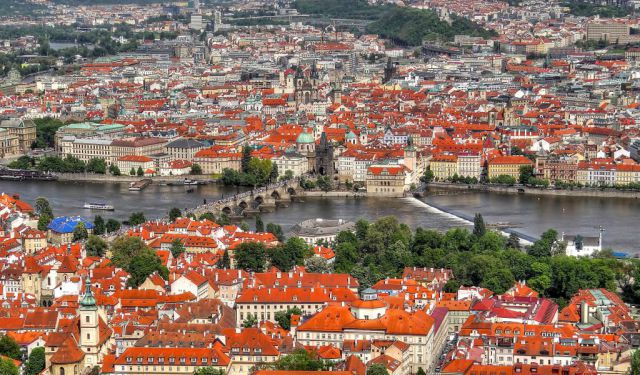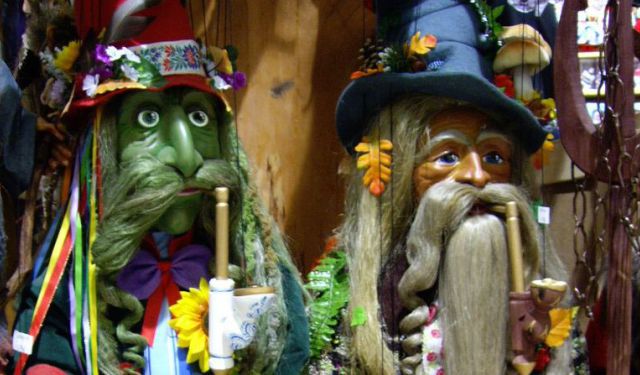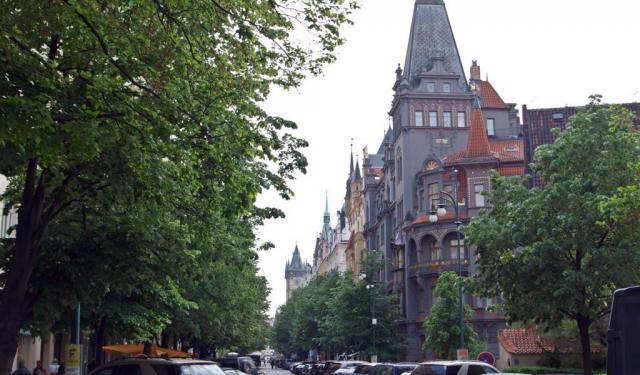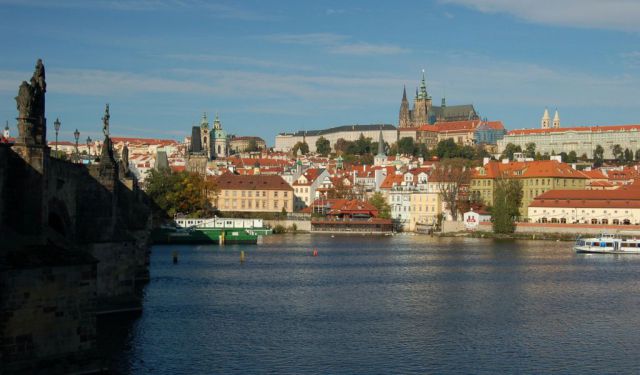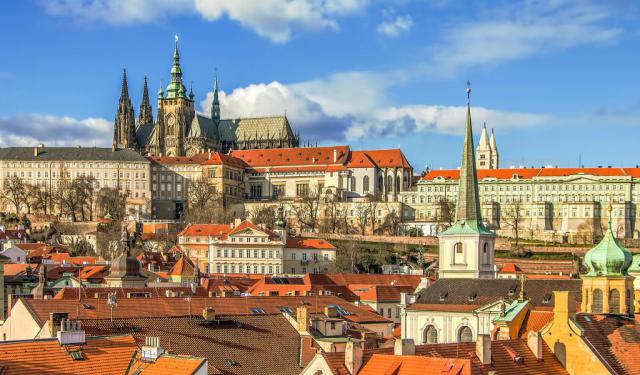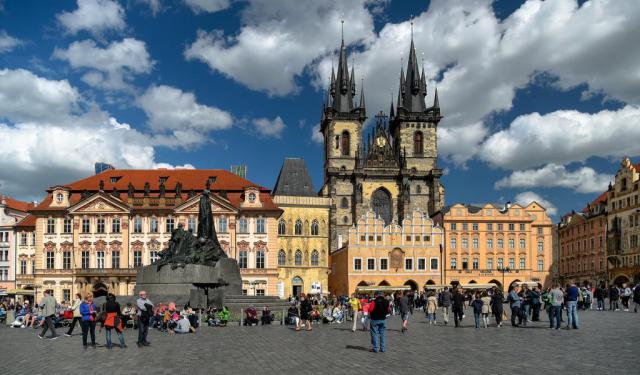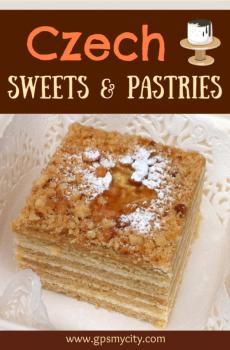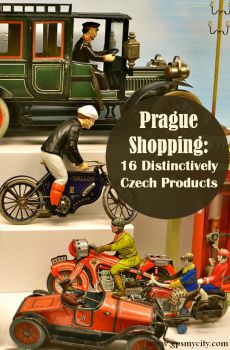New Town Walking Tour (Self Guided), Prague
The youngest (founded in 1348) and the largest (three times the size of the Old Town), the New Town (or Nove Mesto) of Prague is one of the five originally independent townships that today form the historic center of the Czech capital. This vibrant district offers a mix of historical charm and modern amenities and is traditionally dense with tourists.
At its heart lies Wenceslas Square, a bustling hub known for its shops, restaurants, and cultural events. Overlooking the square is the iconic National Museum, a symbol of Czech heritage and pride.
Some distance away you'll find the Jubilee Synagogue, known as the Jerusalem Synagogue for its location, and showcasing a vibrant Moorish style with Art Nouveau influences.
As you stroll along, you can't miss the imposing Saint Henry's Tower, known locally as Jindrisska Vez, offering panoramic views of the cityscape. The elegant Grand Hotel Evropa adds a touch of luxury to the area, with its Art Nouveau architecture and timeless elegance.
For those interested in governance and history, the New Town Hall is a must-visit, showcasing the administrative center of the district. Charles Square – one of the largest squares in the world – provides a tranquil escape, transformed from a bustling medieval marketplace to a serene oasis with lush greenery and Baroque architecture.
Religious landmarks also abound in the area, including the Saints Cyril and Methodius Cathedral, a notable example of neo-Romanesque architecture. And for a taste of modernity, the landmark Dancing House, named so for resembling a pair of dancers, stands as a symbol of the city's contemporary innovation, sparking both controversy and admiration since its completion in 1996.
Whether you're a history buff, a foodie, or simply looking to soak in the atmosphere of one of Europe's most enchanting cities, the New Town of Prague has it all. So plan your visit today and make the most of your time in the Czech capital!
At its heart lies Wenceslas Square, a bustling hub known for its shops, restaurants, and cultural events. Overlooking the square is the iconic National Museum, a symbol of Czech heritage and pride.
Some distance away you'll find the Jubilee Synagogue, known as the Jerusalem Synagogue for its location, and showcasing a vibrant Moorish style with Art Nouveau influences.
As you stroll along, you can't miss the imposing Saint Henry's Tower, known locally as Jindrisska Vez, offering panoramic views of the cityscape. The elegant Grand Hotel Evropa adds a touch of luxury to the area, with its Art Nouveau architecture and timeless elegance.
For those interested in governance and history, the New Town Hall is a must-visit, showcasing the administrative center of the district. Charles Square – one of the largest squares in the world – provides a tranquil escape, transformed from a bustling medieval marketplace to a serene oasis with lush greenery and Baroque architecture.
Religious landmarks also abound in the area, including the Saints Cyril and Methodius Cathedral, a notable example of neo-Romanesque architecture. And for a taste of modernity, the landmark Dancing House, named so for resembling a pair of dancers, stands as a symbol of the city's contemporary innovation, sparking both controversy and admiration since its completion in 1996.
Whether you're a history buff, a foodie, or simply looking to soak in the atmosphere of one of Europe's most enchanting cities, the New Town of Prague has it all. So plan your visit today and make the most of your time in the Czech capital!
How it works: Download the app "GPSmyCity: Walks in 1K+ Cities" from Apple App Store or Google Play Store to your mobile phone or tablet. The app turns your mobile device into a personal tour guide and its built-in GPS navigation functions guide you from one tour stop to next. The app works offline, so no data plan is needed when traveling abroad.
New Town Walking Tour Map
Guide Name: New Town Walking Tour
Guide Location: Czech Republic » Prague (See other walking tours in Prague)
Guide Type: Self-guided Walking Tour (Sightseeing)
# of Attractions: 9
Tour Duration: 2 Hour(s)
Travel Distance: 3.1 Km or 1.9 Miles
Author: Daniel
Sight(s) Featured in This Guide:
Guide Location: Czech Republic » Prague (See other walking tours in Prague)
Guide Type: Self-guided Walking Tour (Sightseeing)
# of Attractions: 9
Tour Duration: 2 Hour(s)
Travel Distance: 3.1 Km or 1.9 Miles
Author: Daniel
Sight(s) Featured in This Guide:
- Wenceslas Square
- National Museum
- Jubilee Synagogue
- St. Henry's Tower (Jindrisska Vez)
- Grand Hotel Evropa
- New Town Hall
- Charles Square
- Ss. Cyril and Methodius Cathedral
- Dancing House
1) Wenceslas Square
A prominent symbol of Czech identity, Wenceslas Square stretches like a lengthy rectangle, traversing from the northwest edge of the New Town to the neo-Renaissance-style National Museum at its southeastern tip.
Originating in the 14th century alongside the establishment of the New Town by Charles IV, the square initially served as a horse market. In the 19th century national revival, it received its current name along with a very fine statue of Saint Wenceslas (“The Good King”) atop his steed, encircled by figures of Saint Agnes of Bohemia, Saint Prokop, Saint Adalbert of Prague, and Saint Ludmila.
Due to its historical significance and central location, Wenceslas Square has been a gathering point for various events throughout history, from Nazi demonstrations to national celebrations and pivotal moments like the Velvet Revolution of 1989.
Today, the square is as busy a spot is ever, attracting locals and tourists alike to visit landmarks such as the National Museum and Prague State Opera, as well as a plethora of offices, hotels, shops, clubs, and eateries flanking its sides.
Tip:
For the quintessential photo of Wenceslas Square, position yourself with Saint Wenceslas' statue behind you. Keep an eye out for the Marks & Spencer shop sign, too, as it marks the balcony where Václav Havel addressed the crowds during the Velvet Revolution in 1989.
Originating in the 14th century alongside the establishment of the New Town by Charles IV, the square initially served as a horse market. In the 19th century national revival, it received its current name along with a very fine statue of Saint Wenceslas (“The Good King”) atop his steed, encircled by figures of Saint Agnes of Bohemia, Saint Prokop, Saint Adalbert of Prague, and Saint Ludmila.
Due to its historical significance and central location, Wenceslas Square has been a gathering point for various events throughout history, from Nazi demonstrations to national celebrations and pivotal moments like the Velvet Revolution of 1989.
Today, the square is as busy a spot is ever, attracting locals and tourists alike to visit landmarks such as the National Museum and Prague State Opera, as well as a plethora of offices, hotels, shops, clubs, and eateries flanking its sides.
Tip:
For the quintessential photo of Wenceslas Square, position yourself with Saint Wenceslas' statue behind you. Keep an eye out for the Marks & Spencer shop sign, too, as it marks the balcony where Václav Havel addressed the crowds during the Velvet Revolution in 1989.
2) National Museum
Located at the heart of Wenceslas Square, Prague's largest museum resides within a majestic neo-Renaissance edifice, casting a commanding presence akin to a colossal golden eagle in mid-flight. Erected between 1885 and 1890, this architectural marvel stands as a testament to the Czech national resurgence of the time. So awe-inspiring is its exterior that in 1968, Soviet troops, in a case of mistaken identity, targeted it as parliament, leaving behind scars of bullet holes and shattered statues during their assault. Although efforts to repair the facade were made in the early 1970s, the remnants of this historical event remain etched in the building's sandstone façade.
The museum's vast collection is a captivating blend of natural history and ethnographic artifacts, boasting an astonishing 14 million items encompassing dinosaur fossils, mineral specimens, textiles, coins, and an array of other treasures. Following extensive renovations, visitors are treated to interactive displays, complemented by rotating exhibitions that add fresh perspectives. Yet, amidst the allure of its exhibits, the museum's architectural splendor continues to captivate, drawing admiration from all who enter. And for those seeking mementos, the gift shop offers an assortment of delights, including brooches crafted from the museum's original parquet flooring.
Tip:
Don't miss the chance to marvel at the opulent marble entrance hall and the grand monumental staircase leading to the glass-domed Pantheon, adorned with 48 busts and statues honoring notable Czech figures, alongside a select few women and Slovaks.
The museum's vast collection is a captivating blend of natural history and ethnographic artifacts, boasting an astonishing 14 million items encompassing dinosaur fossils, mineral specimens, textiles, coins, and an array of other treasures. Following extensive renovations, visitors are treated to interactive displays, complemented by rotating exhibitions that add fresh perspectives. Yet, amidst the allure of its exhibits, the museum's architectural splendor continues to captivate, drawing admiration from all who enter. And for those seeking mementos, the gift shop offers an assortment of delights, including brooches crafted from the museum's original parquet flooring.
Tip:
Don't miss the chance to marvel at the opulent marble entrance hall and the grand monumental staircase leading to the glass-domed Pantheon, adorned with 48 busts and statues honoring notable Czech figures, alongside a select few women and Slovaks.
3) Jubilee Synagogue
Also referred to as the Jerusalem Synagogue for its location on Jerusalem Street, the Jubilee Synagogue was named in honor of Emperor Franz-Josef I of Austria's sixtieth year of reign in 1908. As the latest and largest addition to Prague's Jewish community, its construction showcases a vibrant Moorish style reminiscent of the Spanish Synagogue in Josefov, embellished with touches of Art Nouveau, particularly evident within its interiors. The Mudéjar red-and-white stone facade adds to its visual allure, striking observers with its distinctiveness. Despite recent renovations, the synagogue remains dedicated to its religious purpose.
After nearly a century of serving as a place of worship, the Jubilee Synagogue began welcoming tourists and enthusiasts of historic architecture regularly starting April 1, 2008. Now transformed into a cultural and exhibition venue, it hosts concerts where visitors can experience the uniquely preserved original organ. The facade bears a meaningful Hebrew inscription from Malachi, promoting a message of unity and optimism: "Do we not have one father? Were we not created by the same God?"
After nearly a century of serving as a place of worship, the Jubilee Synagogue began welcoming tourists and enthusiasts of historic architecture regularly starting April 1, 2008. Now transformed into a cultural and exhibition venue, it hosts concerts where visitors can experience the uniquely preserved original organ. The facade bears a meaningful Hebrew inscription from Malachi, promoting a message of unity and optimism: "Do we not have one father? Were we not created by the same God?"
4) St. Henry's Tower (Jindrisska Vez)
The tallest standalone belfry in Prague (67.7 meters), this whimsical tower, a late Gothic landmark from the 15th century, is a part of the Church of Saint Henry on Jindřišská Street. Notably, since the 14th century, this street has connected Prague's three main squares – Wenceslas, Charles, and Senovážné.
Erected in 1475, the tower has endured numerous damages over the years, whether from foreign invaders (such as the Swedes in 1648) or natural calamities (like a massive storm that blew off the roof in 1801). In addition to the clock installed in 1577, another distinctive feature is the carillon – a set of ten bronze bells digitally controlled to ring out every fifteen minutes, playing an entire medley every four hours.
Unlike other surviving towers in Prague, this one has undergone imaginative and costly restoration, now equipped with full air conditioning, electric lighting, a staircase, and a fast elevator servicing its ten floors. Today, it houses a café, restaurant, shop, exhibition area, and a small museum on Prague's numerous towers, offering a splendid view of the city's rooftops from the top floor.
Erected in 1475, the tower has endured numerous damages over the years, whether from foreign invaders (such as the Swedes in 1648) or natural calamities (like a massive storm that blew off the roof in 1801). In addition to the clock installed in 1577, another distinctive feature is the carillon – a set of ten bronze bells digitally controlled to ring out every fifteen minutes, playing an entire medley every four hours.
Unlike other surviving towers in Prague, this one has undergone imaginative and costly restoration, now equipped with full air conditioning, electric lighting, a staircase, and a fast elevator servicing its ten floors. Today, it houses a café, restaurant, shop, exhibition area, and a small museum on Prague's numerous towers, offering a splendid view of the city's rooftops from the top floor.
5) Grand Hotel Evropa
Perched on the edge of the renowned Wenceslas Square, this building stands as one of Prague's most striking architectural landmarks. Originally constructed in 1872 in the neo-Renaissance style, subsequent renovations in 1903–05 saw it transformed into a geometric Art Nouveau masterpiece, reflecting the trends of the time. Notably, Franz Kafka hosted his only author reading in Prague here in 1912.
In 1924, restaurateur Karel Šroubek acquired the property, renaming it Hotel Šroubek. It quickly gained renown throughout Czechoslovakia and beyond as a prestigious, luxurious, and modern establishment. After nationalization three decades later, it became known as Grand Hotel Evropa; however, over time, it fell into disrepair until its denationalization in 1989.
Since 2016, extensive reconstruction has been underway, including the addition of a new eight-story building in the courtyard, aimed at expanding its capacity. This expansion includes conference facilities, a wellness complex, and a panoramic restaurant. Despite these changes, the building's symmetrical Art Nouveau facade remains beautifully preserved, adorned with intricate plant motifs and topped with a golden sculpture bearing a globe-shaped lamp symbolizing Europe.
The hotel's ornate interior, beloved by filmmakers, has been featured in various movies, including "Titanic" and "Mission Impossible."
In 1924, restaurateur Karel Šroubek acquired the property, renaming it Hotel Šroubek. It quickly gained renown throughout Czechoslovakia and beyond as a prestigious, luxurious, and modern establishment. After nationalization three decades later, it became known as Grand Hotel Evropa; however, over time, it fell into disrepair until its denationalization in 1989.
Since 2016, extensive reconstruction has been underway, including the addition of a new eight-story building in the courtyard, aimed at expanding its capacity. This expansion includes conference facilities, a wellness complex, and a panoramic restaurant. Despite these changes, the building's symmetrical Art Nouveau facade remains beautifully preserved, adorned with intricate plant motifs and topped with a golden sculpture bearing a globe-shaped lamp symbolizing Europe.
The hotel's ornate interior, beloved by filmmakers, has been featured in various movies, including "Titanic" and "Mission Impossible."
6) New Town Hall
At the northern edge of Charles Square, the New Town Hall has a late-Gothic tower reminiscent of its counterpart in the Old Town Hall, alongside three imposing Renaissance gables. Throughout its existence, this building has been a silent witness to many historic events, including the infamous Defenestration of Prague on July 30th, 1419. During this event, a crowd of townspeople, followers of the martyred religious reformer Jan Hus, forcibly ejected Catholic town councilors from the windows, marking the beginning of the Hussite revolution. Later, in 1609, the Bohemian nobility convened here to compel Emperor Rudolf II to issue a decree guaranteeing religious freedoms.
Initially serving as the seat of the New Town government, the building's role changed in 1784 when Emperor Josef II merged Prague's four towns. It was then repurposed as a courthouse and prison, earning the moniker "Prague’s Bastille". Interestingly, two wards of the ground-floor prison are named after their first inmates, Polévka (soup) and Jelito (pork-blood sausage).
In 1905, a significant reconstruction effort stripped away traces of the Classicist remodeling from the early 19th century, restoring the Hall to its original Renaissance appearance from the early 16th century. A more recent overhaul, spanning from 1976 to 1996, tailored the premises to the needs of the Prague 2 Municipal Office, while also accommodating regular exhibitions and contemporary art shows. Additionally, Café Neustadt in the courtyard offers a cozy retreat, and visitors can ascend the tower for a panoramic view of the New Town. Similar to the Old Town Hall, this venue remains a popular choice for weddings.
Initially serving as the seat of the New Town government, the building's role changed in 1784 when Emperor Josef II merged Prague's four towns. It was then repurposed as a courthouse and prison, earning the moniker "Prague’s Bastille". Interestingly, two wards of the ground-floor prison are named after their first inmates, Polévka (soup) and Jelito (pork-blood sausage).
In 1905, a significant reconstruction effort stripped away traces of the Classicist remodeling from the early 19th century, restoring the Hall to its original Renaissance appearance from the early 16th century. A more recent overhaul, spanning from 1976 to 1996, tailored the premises to the needs of the Prague 2 Municipal Office, while also accommodating regular exhibitions and contemporary art shows. Additionally, Café Neustadt in the courtyard offers a cozy retreat, and visitors can ascend the tower for a panoramic view of the New Town. Similar to the Old Town Hall, this venue remains a popular choice for weddings.
7) Charles Square
Charles Square, spanning an impressive 80,550 square meters, ranks among the largest squares globally and holds the distinction of being the largest town square in medieval Europe. Emperor Charles IV laid its foundations in 1348, intending for it to become the principal square of the New Town, hence the construction of the New Town Hall here. Initially known as the Cattle Market from the 15th century due to drovers trading their herds, it was renamed in honor of its founder in 1848.
In the 17th century, the Jesuits commenced the construction of their New Town residence within Charles Square; they also erected a new church between 1655 and 1677, designed in the early Baroque style and dedicated to their patron saint, Ignatius of Loyola. Additionally, on the square's southern side stands a High Baroque-style gate leading to the Church of Saint John of Nepomuk, built in the 1730s.
Today, Charles Square serves more as a haven for relaxation than a hub of radical protest. Divided by bustling tram tracks and traffic, its two rectangular halves of green space are adorned with trees, flower gardens, a Baroque fountain, winding pathways, and benches, creating a tranquil ambiance perfect for unwinding.
In the 17th century, the Jesuits commenced the construction of their New Town residence within Charles Square; they also erected a new church between 1655 and 1677, designed in the early Baroque style and dedicated to their patron saint, Ignatius of Loyola. Additionally, on the square's southern side stands a High Baroque-style gate leading to the Church of Saint John of Nepomuk, built in the 1730s.
Today, Charles Square serves more as a haven for relaxation than a hub of radical protest. Divided by bustling tram tracks and traffic, its two rectangular halves of green space are adorned with trees, flower gardens, a Baroque fountain, winding pathways, and benches, creating a tranquil ambiance perfect for unwinding.
8) Ss. Cyril and Methodius Cathedral
A notable landmark in the Karlín district and one of Prague's largest religious structures, this striking black-and-white church is dedicated to the Orthodox missionaries Cyril and Methodius, known for their role in spreading Christianity throughout Slavic territories. It was consecrated in 1863, marking exactly 1,000 years since the brothers began their influential mission.
During World War II, the cathedral's crypt sheltered seven Allied paratroopers who assassinated Reinhard Heydrich, the Nazi Governor of Bohemia and Moravia. Betrayed by locals, four of them were cornered by the Gestapo in the crypt and ultimately took their own lives to avoid capture. The clergy and several civilians were arrested and executed for their involvement. The Nazis eventually desecrated the cathedral and closed all Orthodox churches in Czechoslovakia in 1942.
Inside the neo-Romanesque basilica, visitors can admire decorative pillars, intricately painted ceilings, and an Art Nouveau baptismal chapel. Situated on Karlínské Square, the church is at the heart of the neighborhood, where farmers' markets, festivals, and cultural events frequently take place.
During World War II, the cathedral's crypt sheltered seven Allied paratroopers who assassinated Reinhard Heydrich, the Nazi Governor of Bohemia and Moravia. Betrayed by locals, four of them were cornered by the Gestapo in the crypt and ultimately took their own lives to avoid capture. The clergy and several civilians were arrested and executed for their involvement. The Nazis eventually desecrated the cathedral and closed all Orthodox churches in Czechoslovakia in 1942.
Inside the neo-Romanesque basilica, visitors can admire decorative pillars, intricately painted ceilings, and an Art Nouveau baptismal chapel. Situated on Karlínské Square, the church is at the heart of the neighborhood, where farmers' markets, festivals, and cultural events frequently take place.
9) Dancing House (must see)
One of Prague's most renowned modern landmarks, the Dancing House is the nickname given to the Nationale-Nederlanden building in downtown. Designed collaboratively by Canadian-American architect Frank Gehry (known for his work on the Guggenheim Bilbao) and his Croatian-Czech partner Vlado Milunić, the building occupies a vacant riverfront plot that was once the site of a structure destroyed during the Bombing of Prague in 1945. Completed in 1996, its unconventional design sparked controversy upon unveiling.
Supported by Czech President Václav Havel, who had resided nearby for many years, the building was envisioned as a hub of cultural activity. Originally dubbed "Fred and Ginger" after the iconic dance duo Fred Astaire and Ginger Rogers, due to its resemblance to a pair of dancers, the structure stands in stark contrast to Prague's predominant Baroque, Gothic, and Art Nouveau architecture. Yet, the intertwined glass and stone towers flanking the Vltava River symbolize the city's delicate balance between its rich historical heritage and its evolving modern identity.
Playfully nicknamed the "Drunk House" by locals, it now houses a hotel and a top-floor restaurant offering panoramic views of the city. Even if you don’t plan to stay or dine there, admiring the building itself, whether from the near or far side of the river, is well worth it.
Tip:
Take the elevator to the Glass Bar on the top floor and enjoy any beverage to gain access to the 360-degree viewing platform.
Supported by Czech President Václav Havel, who had resided nearby for many years, the building was envisioned as a hub of cultural activity. Originally dubbed "Fred and Ginger" after the iconic dance duo Fred Astaire and Ginger Rogers, due to its resemblance to a pair of dancers, the structure stands in stark contrast to Prague's predominant Baroque, Gothic, and Art Nouveau architecture. Yet, the intertwined glass and stone towers flanking the Vltava River symbolize the city's delicate balance between its rich historical heritage and its evolving modern identity.
Playfully nicknamed the "Drunk House" by locals, it now houses a hotel and a top-floor restaurant offering panoramic views of the city. Even if you don’t plan to stay or dine there, admiring the building itself, whether from the near or far side of the river, is well worth it.
Tip:
Take the elevator to the Glass Bar on the top floor and enjoy any beverage to gain access to the 360-degree viewing platform.
Walking Tours in Prague, Czech Republic
Create Your Own Walk in Prague
Creating your own self-guided walk in Prague is easy and fun. Choose the city attractions that you want to see and a walk route map will be created just for you. You can even set your hotel as the start point of the walk.
Prague Introduction Walking Tour
Nicknamed the “City of a Hundred Spires,” Prague is a living gallery of history and architecture, home to world-class museums, eclectic galleries, numerous theaters, and a seemingly endless collection of historic landmarks.
The name Praha comes from the old Slavic word “práh”, which means “rapid”, nodding to the city's beginnings at a crossing on the Vltava River. Legend... view more
Tour Duration: 2 Hour(s)
Travel Distance: 3.2 Km or 2 Miles
The name Praha comes from the old Slavic word “práh”, which means “rapid”, nodding to the city's beginnings at a crossing on the Vltava River. Legend... view more
Tour Duration: 2 Hour(s)
Travel Distance: 3.2 Km or 2 Miles
Old Town Souvenir Shopping
Strolling through the Old Town of Prague, souvenir shopping becomes a delightful adventure. Indeed, it would be a pity to leave Prague without having explored its specialty shops and bringing home something truly original and unique to the city.
One of the prime spots for such endeavors is the Municipal House, a majestic Art Nouveau building that houses various shops and boutiques. Here,... view more
Tour Duration: 1 Hour(s)
Travel Distance: 1.7 Km or 1.1 Miles
One of the prime spots for such endeavors is the Municipal House, a majestic Art Nouveau building that houses various shops and boutiques. Here,... view more
Tour Duration: 1 Hour(s)
Travel Distance: 1.7 Km or 1.1 Miles
Jewish Quarter Walking Tour
The Jewish Quarter of Prague carries over a thousand years of memory etched into its streets, synagogues, and gravestones. Jewish communities began settling in this area as early as the 10th century, and although they were later forced into a walled ghetto, they cultivated a vibrant cultural and intellectual life-especially during the 16th century, a golden age shaped by the influence of Rabbi Ben... view more
Tour Duration: 1 Hour(s)
Travel Distance: 1.1 Km or 0.7 Miles
Tour Duration: 1 Hour(s)
Travel Distance: 1.1 Km or 0.7 Miles
Lesser Town Walking Tour
Malá Strana, or the “Lesser Town,” lies along the left bank of the Vltava River and remains one of Prague’s most charming and historically layered districts. In medieval times, it was primarily settled by ethnic Germans, and even as Baroque architecture reshaped the neighborhood following the devastating fire of 1541, the area held onto its Germanic roots for generations. Its location near... view more
Tour Duration: 2 Hour(s)
Travel Distance: 3.9 Km or 2.4 Miles
Tour Duration: 2 Hour(s)
Travel Distance: 3.9 Km or 2.4 Miles
Hradcany (Castle District) Walking Tour
Prague’s Castle District is a neighborhood where history feels almost tangible-an atmospheric blend of towering landmarks, quiet courtyards, and sweeping city views. At its heart sits the mighty Prague Castle, often cited as the largest castle complex in the world. Its origins stretch back to the 9th century, and over time, it has been home to Bohemian kings, Holy Roman emperors, Communist... view more
Tour Duration: 2 Hour(s)
Travel Distance: 3.0 Km or 1.9 Miles
Tour Duration: 2 Hour(s)
Travel Distance: 3.0 Km or 1.9 Miles
Old Town Walking Tour
Prague’s Old Town is a living tapestry of medieval roots and vibrant modern life, wrapped in narrow cobblestone streets and brimming with architectural treasures. Once a self-contained settlement, it was protected by a semi-circular moat and a fortified wall, both tracing the curve of the Vltava River. Although the moat is long gone, its path survives in the form of key streets-most notably Na... view more
Tour Duration: 2 Hour(s)
Travel Distance: 2.8 Km or 1.7 Miles
Tour Duration: 2 Hour(s)
Travel Distance: 2.8 Km or 1.7 Miles
Useful Travel Guides for Planning Your Trip
Czech Sweets and Pastries
Once part of the Austro-Hungarian Empire, the Czechs have duly absorbed the dessert-making know-how of their Austrian neighbors to complement their own confectionery heritage deeply rooted in the Eastern European, Slavic tradition. The end result of such cultural blend is the abundance of pastries,...
Prague Shopping: 15 Distinctively Czech Products to Bring Home
Previously known mainly for its beer and ice-hockey (both for a very good reason), today's Czech Republic - and, primarily, its capital city Prague - is seen among the top European tourist destinations emerged following the breakup of the Soviet Bloc. A shooting ground for some Hollywood...
The Most Popular Cities
/ view all
